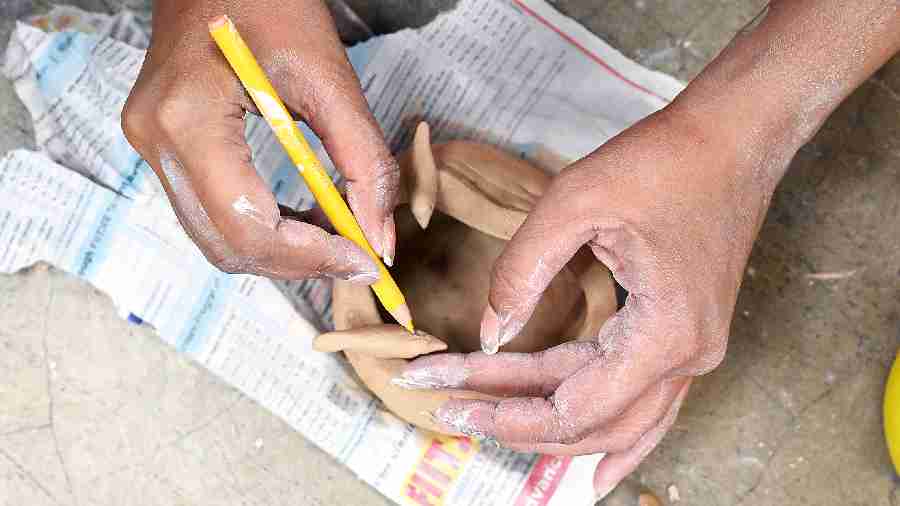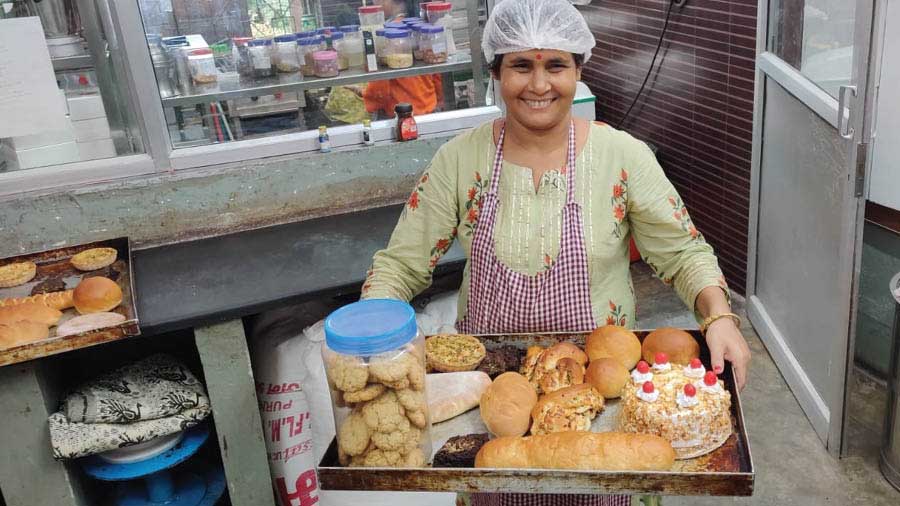When Pratyay was being planned, the first things that were marked to be pulled down were the grilles, fan covers and lights.
Pratyay is an assisted living space in Picnic Garden in Calcutta, located in the building where the old Lumbini Park Mental Hospital was. When the hospital moved into its new premises, on the other side of the road, the old building was converted into a space for assisted living for recovered mental health patients. A second Pratyay has been set up at Behrampore.
The idea is to enable the residents to lead a life of independence and dignity, and find livelihoods. It was imperative that the new place did not carry over memories of a mental hospital. Pratyay, meaning resolve, is the first space of its kind in Bengal. It was inaugurated on July 7, 2022, by chief minister Mamata Banerjee.
Of the 36 residents, nine have found work. Finding paid work is a priority for Pratyay residents as it can contribute towards mainstreaming them and integrating them with society.
The first step is to feel free.
The old Lumbini Park hospital had grilles that rose from the floor to almost the ceiling, making the space where the residents lived look like a giant cage. The residents — the men lived on the ground floor — peered at passers-by, craning their necks or pressing their faces against the metal bar. All around were collapsible gates with huge locks. Every resident was under watch. The place looked like a prison. We often forget that both freedom and health are rooted in one’s experience of the physical space one inhabits and in one’s control over one’s movements. We also forget that institutions that punish and offer treatment can look like each other. Not for nothing is “pagla garod” the Bengali word for a mental asylum, garod meaning prison.
“We wanted an open, airy, wellventilated space,” says Sanghamitra Ghosh, principal secretary of the department of women and child development and social welfare in the Bengal government. The mental health and clinical support for Pratyay are provided by the health and family welfare department, and the operations are managed by the women and child development and social welfare department. For Pratyay in Calcutta, Anjali, a mental health rights NGO, was chosen to partner the government departments. Anjali manages the care and employment concerns of the residents.
The building looks so transformed now that for the first time, one realises what a beautiful, sprawling structure it is, with an open courtyard that lets in a flood of light into the ground floor. Once it was a residential building, but its architecture was obscured by the hospital. The entrance now leads to a library with a painting by Sudip Banerjee; the cage-like area is now a lobby where the residents meet or attend classes; dorms and smaller rooms line one side of the building and beyond the courtyard is the brightly-lit dining space with green furniture. The walls are blue, green and pink. The place looks like a pleasant working hostel. Perhaps more cheerful, more like a happy tourist lodge. Pratyay can house 100 people, 50 men and 50 women.
The lobby upstairs is the TV area, with a giant set on the wall.
The fan covers, metal sheaths covering ceiling fans to stop hospital residents from hanging themselves, had to go, too. “The assumption is that all mental health patients are dangerous people,” says Ratnaboli Ray of Anjali. Instead of depressing, glaring lights, Pratyay is now softly lit with low-hanging lamps.
The gates are open for the better part of the day. The residents, who can manage their daily lives more or less on their own, including taking their medicines on a maintenance dose, are monitored but are not under surveillance.
One person who was selected to come to Pratyay — recovered patients from Lumbini Park and Pavlov, government mental hospitals, are staying here — decided against joining, because Pratyay reminded her too much of home, says Ray. Freedom can be both exhilarating and terrifying. “Because it asks you to exercise your own agency,” says Ray. Which long periods of institutionalisation can severely damage.
But institutionalisation for mental health patients is almost always long. They have no takers. They may not have families, and when they do, the families often do not want them back. This leads to extremely overcrowded mental health hospitals, which, Ghosh reminds, is one major reason that led to Pratyay. “We had felt the necessity to decongest mental health hospitals for some time,” she says.
The Mental Healthcare Act, 2017, and the subsequent Supreme Court orders to set up a halfway home for recovered patients provided the push.
Ray prefers to describe Pratyay as an assisted living space because the phrase has an inherent sense of respect, she feels. Besides, the aim is to move away from a clinical and pathological vocabulary as much as possible. “We are trying to set up a culture that is based on recognising personhood, and not reducing someone to a person with illness,” says Ray.
The real challenge is finding work for the Pratyay residents. Or reuniting them with their families with their sense of agency intact, or, even more difficult, helping them access family property, something mental health patients, recovered or otherwise, are routinely denied.
Among the nine residents who are working, one is employed at a printing press, another as a nurse at a nursing home. Three are working as security personnel. One trained in block printing is leading the Anjali block printing unit. He also teaches science to children in red-light areas.
A few Pratyay residents who were employed have returned because they were not able to adjust to the workplace. Another challenge is the paperwork. For most residents, their identity has to be reconstructed, literally. Their identity documents are missing or have to be made. This is a Herculean task, says Abhijit Roy of Anjali, who is project manager at Pratyay.
Everything is a challenge, says Ghosh. And it may not be fair to measure success here with numbers.
“We are dealing with very marginal, very vulnerable people,” she says. They have very special requirements and need to heal. They need constant hand-holding, which is slow, quiet, long work. “As a result, even if one person is helped, it is a life-changing event,” says Ghosh.
Though a Pratyay resident’s needs may be special, in a way they are also not, she adds. As with the body, the mind may be all right sometimes, sometimes not. Mental illness is not an irreversible, absolute thing.
But at Pratyay, the residents are already working. They are engaged in gardening, baking and making ceramic items and dolls. The dolls are the most spectacular. Made of cloth, they are fierce and proud and prettily dressed and stare out at the world.












